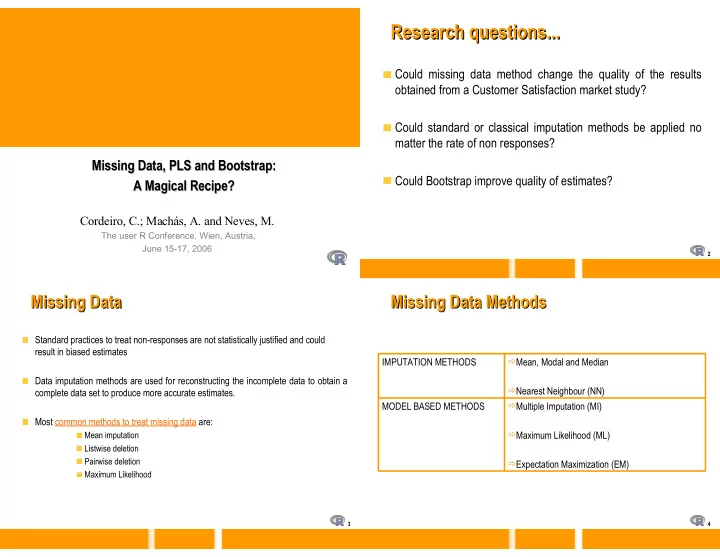

Research questions... Research questions... Could missing data method change the quality of the results obtained from a Customer Satisfaction market study? Could standard or classical imputation methods be applied no matter the rate of non responses? Missing Data, PLS and Bootstrap: Missing Data, PLS and Bootstrap: Could Bootstrap improve quality of estimates? A Magical Recipe? A Magical Recipe? Cordeiro, C.; Machás, A. and Neves, M. The user R Conference, Wien, Austria, June 15-17, 2006 2 Missing Data Missing Data Methods Missing Data Missing Data Methods Standard practices to treat non-responses are not statistically justified and could result in biased estimates IMPUTATION METHODS Mean, Modal and Median Data imputation methods are used for reconstructing the incomplete data to obtain a Nearest Neighbour (NN) complete data set to produce more accurate estimates. MODEL BASED METHODS Multiple Imputation (MI) Most common methods to treat missing data are: Mean imputation Maximum Likelihood (ML) Listwise deletion Pairwise deletion Expectation Maximization (EM) Maximum Likelihood 3 4
Missing Data and Bootstrap Missing Data and Bootstrap Bootstrap and SEM-PLS on CSM Case Study: Bootstrap and SEM-PLS on CSM Case Study: ACSI Model for Mobile Telecom (Fornell, C) Efron(1994) uses the extensive imputation theory developed by Rubin(1987) SEM estimated with PLS algorithm (Chin, W) Data treatment for missing data: Standard procedure Mean imputation The simplest nonparametric bootstrap approach: The rows in the original data matrix are resampled with replacement STRUCTURAL MODEL MEASUREMENT MODEL (number of questions) Image 5 Image A bootstrap matrix is obtained and a bootstrap estimate is calculated for the parameter in Expectations 3 study Quality 8 Expect CS CL Value 2 So an extensive computer work is performed, repeating the above procedure several times; Value a large number of estimates are calculated and imputed in the original data. Customer Satisfaction 3 Customer Loyalty 2 Quality ACSI Model, with Image like in EPSI Model 5 6 Methodological aspects Methodological aspects Using R Using R Bootstrap application in R Compared scenarios: Compared scenarios: Step1: matrix rows are resampled with replacement; 10% Rate of non responses from Original Data Matrix X = 1 st scenario 50% Rate of non-responses from Simulated Data Matrix Y= 2 nd scenario Step2: a bootstrap sample is obtained; 60 55 57 55 55 56 56 54 Step3: a bootstrap estimate is computed according to the missing data 53 52 52 52 52 51 50 50 50 50 50 49 Rate of non responses (%) 48 46 46 50 44 method; 40 30 Step4: go to step1. 20 10 10 8 7 7 6 6 6 6 10 5 5 4 4 4 4 3 3 2 2 1 1 1 0 0 1st scenario 2nd scenario 7 8
Case Study questions... Using R Case Study questions... Using R This procedure was repeated r=5000 times; ? How the classical missing data techniques perform for the two scenarios Missing values in scenarios 1 and 2, are replaced with new ? How the Bootstrap perform with the missing data techniques for the estimates generated by 5000 replications; two scenarios Then, a new PLS estimation is performed. ? What conclusion based on quality measures of model adjustment like: RSquared, Residual Variance…. Both scenarios, using bootstrap methodology, were compared with the classical situation (CSM estimation based on PLS, where Mean Imputation is the ad hoc procedure adopted for ECSI/EPSI model). 9 10 Conclusion The work still goes on... Conclusion The work still goes on... Perform an extensive theoretical work 1st Scenario (10%): Bootstrap methodology doesn't increase the quality of estimates Improve some performance methods 2nd Scenario (50%): Bootstrap methodology used with Hot Deck Imputation and K Nearest Neighbor achieves good results Explore other bootstrap approaches to the estimation in the problem Overall, it was seen that for a higher non- response rates, bootstrap of missing is the best method to be adopted in case of missing data completely at random. THANK YOU 11 12
Recommend
More recommend